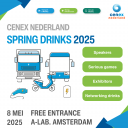Within less then one year shared electric scooters (I would say electric steps) are gaining ground very fast in already 65 cities in the USA. They might become a dream solution for the first and last miles, much better than the growing deployment of Ubers at these short distances. In my newest blogpost I deal with these and other micro-mobility solutions for the future.
You will find the Dutch version of this post here: https://wp.me/p32hqY-1GS
Want to receive updates like this in your inbox?
Get notified about new updates, opportunities or events that match your interests.
Maybe you will also like these updates
The Amsterdam Hunger Game

Learn with the case study Amsterdam to anticipate future food disruptions. Understand the city's food supply chain vulnerabilities is critical for enhancing food resilience. Enhance food resilience in empowerment of people in urban food growing.
🚨 𝗪𝗲'𝗿𝗲 𝗮𝗹𝗿𝗲𝗮𝗱𝘆 𝗮𝘁 𝟱𝟬% – 𝗮𝗻𝗱 𝘄𝗲 𝗵𝗮𝘃𝗲𝗻'𝘁 𝗲𝘃𝗲𝗻 𝗸𝗶𝗰𝗸𝗲𝗱 𝗼𝗳𝗳 𝘆𝗲𝘁! 🚨

Wow! Half of the tickets for our Cenex Nederland Lenteborrel have already been ordered – and the event isn’t even happening until 8th of May 2025. 🎉
That means: lots of excitement, high expectations, and... an opportunity you don’t want to miss.
The event will be focusing on Transport & Mobility, Circular Mobility, Energy & Infrastructure, where you can expect the following.
📍 What to expect:
✅ Meet exhibitors and explore the latest innovations
🎮 Join or watch two exciting serious game sessions
🎤 Be inspired by four engaging keynotes (English)
🥂 End the day with our annual spring reception where you have the opportunity to network.
Want to join us? Don’t wait too long – the remaining 50% is likely to go even faster. 🎫
Please make sure to get your (free) ticket via Eventbrite
Stream the Amsterdam Forever Young Programme on Eye Film Player

Discover the Amsterdam Forever Young program on the Eye Film Player, a diverse programme that explores the dynamic, ever-evolving spirit of Amsterdam. This collection of films highlights how the city’s unique identity has been shaped by its past, present, and future. Hence, we place a special focus on the intersection of urban development and planning, offering a look at how the city’s architectural and cultural transformations have intertwined in, both, historical films, as well as more contemporary filmic undertakings. Thus, our collection of films, such as Where the Rats are King, A Photographer Films Amsterdam and Amsterdam Global Village, shed light on the living conditions in Amsterdam, the urban communities witihin Amsterdam and, even, films as Jenny and Amsterdam on Film that shed light on how the canals have shaped Amsterdam more than aesthetically e.g., with its focus on ecology and care for our climate. Through, both, monetized and free to watch films, we aim to share the rich history of our city, whilst aiming for a dynamic space for creativity, inclusivity, and sustainability in the future, too that we hope this knowledge and collection will inspire.
All in all, Amsterdam Forever Young invites you to reflect on the city's evolution and its commitment to being a centre of modernity, without losing the essence of its heritage. Available on the Eye Film Player, to watch from your bedroom, this "digital" exhibition celebrates Amsterdam as the city of urban transformation that, at the same time, stay true to its historical roots.


Hi Samantha. I did not spend too many thoughts about the conditions in Amsterdam. One thing is clear. In Amsterdam there is no place for e-steps or any additional form of transport unless the available space is redistributed at the expense of cars.
In case of their appearance in Dutch town a serious debate has to take place about the conditions under which they might become a blessing for mobility. One of the issues will be a more or less orderly way of parking.
I wrote this post in the first place as a contribution to the debate about mobility within the first and last miles. In the Netherlands cycling and walking are without much dispute considered as the first options. However, the shared e-step might be a serous (partial) alternative, because of its compactness, flexibility and cheapness.
Hello! I'm so curious how you see the dockless scooter situation playing out in Amsterdam. I am located in Denver and, since the electric scooter systems are dockless, I often see Lime and Bird scooters lying on the sidewalks and in the public rights-of-way. I worry about this more than the creation/re-allocation of scooter lanes. It hasn't become too much of an issue or inconvenience yet since the scooters are new and relatively few in comparison to other types of transportation, but Denver, like many other cities in especially the western United States is quite spread out. Contrarily, Amsterdam is more compact, its space strategically alotted and it seems no space is unused. I don't see much extra room for the haphazard collections of unused electric scooters. Do you think the model will have to be adjusted to a more orderly version (although I imagine the joy of the shared electric scooter system is the user's complete freedom in mobility to reach the last meter, moreso than the alternative docked rental bikes); do you foresee scooter usership becoming bigger, and in some ways replacing, bicycle usership? Very curious to get your perspective!